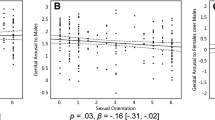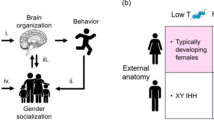Abstract
Previous research suggests that individuals’ sexual orientation may be affected by developmental instability (DI) induced by exposure to prenatal stresses. We tested this relationship using fluctuating asymmetry (FA), the small random deviations from symmetry that arise in otherwise bilaterally symmetrical traits as a consequence of developmental noise and developmental instability. Differences among individuals reflect variation in their exposure to and ability to accommodate for stresses experienced during development as well as to developmental noise that arises due to cellular stocasticity. FA measurements for 156 heterosexual and 132 homosexual men and women participants provided strong support for the developmental instability hypothesis: FA was significantly higher in both male and female homosexuals (men: four of seven bilateral traits and composite FA values (cFA); women: five of seven bilateral traits and composite FA values). Although finger-length ratios (FLRs), an indirect marker for prenatal hormones, were sex-atypical (e.g., feminized) for homosexual men, we failed to detect any relationship between FA levels and 2D:4D finger-length ratios (FLRs). Hence, although elevated levels of developmental stress appear to be linked to shifts in sexual orientation, the underlying mechanism does not seem to be connected to sex-atypical prenatal hormones. Additional analyses with sex atypical individuals are needed to confirm this.
Similar content being viewed by others
References
Allen, L. S., & Gorski, R. A. (1992). Sexual orientation and the size of the anterior commissure in the human brain. Proceedings of the National Academy of Sciences, 89, 7199–7202.
Bailey, J. M., & Benishay, D. S. (1993). Familial aggregation of female homosexuality. American Journal of Psychiatry, 150, 272–277.
Bailey, J. M, Dunne, M. P., & Martin, N. G. (2000). Genetic and environmental influences on sexual orientation and its correlates in an Australian twin sample. Journal of Personality and Social Psychology, 78, 524–536.
Bailey, J. M., & Pillard, R. C. (1991). A genetic study of male sexual orientation. Archives of General Psychiatry, 48, 1089–1096.
Bailey, J. M., Pillard, R. C., Dawood, K., Miller, M. B., Farrer, L. A., Trivedi, S., et al. (1999). A family history study of male sexual orientation using three independent samples. Behavior Genetics, 29, 79–86.
Bernstein, L. S., Gordon, T. P., & Rose, R. M. (1983). The interaction of hormones, behavior and social context in non-human primates. In B. B. Svare (Ed.), Hormones and aggressive behavior (pp. 535–561). New York: Plenum Press.
Blanchard, R. (2001). Fraternal birth order and the maternal immune hypothesis of male homosexuality. Hormones and Behavior, 40, 105–114.
Blanchard, R., & Bogaert, A. F. (1996). Homosexuality in men and number of older brothers. American Journal of Psychiatry, 153, 27–31.
Blanchard, R., Cantor, J., Bogaert, A. F., Breedlove, M., & Ellis, L. (2006). Interaction of birth order and handedness in the development of male homosexuality. Hormones and Behavior, 49, 405–414.
Blanchard, R., & Ellis, L. (2001). Birth weight, sexual orientation and the sex of preceding siblings. Journal of Biosocial Science, 33, 451–467.
Bogaert, A. F., & Hershberger, S. (1999). The relationship between sexual orientation and penile size. Archives of Sexual Behavior, 28, 213–221.
Brown, W. M., Williams, C., Cooke, B., & Breedlove, M. (2002). Differences in finger length ratios between self identified butch and femme lesbians. Archives of Sexual Behavior, 31, 123–127.
Byne, W., Tobet, S., Mattiace, L., Lasco, M., Kemether, E., Edgar, M., et al. (2001). The interstitial nuclei of the human anterior hypothalamus: An investigation of variation with sex, sexual orientation, and HIV status. Hormones and Behavior, 40, 86–92.
Cohen, J. (1992). A power primer. Psychological Bulletin, 112, 155–159.
Cote, K., Blanchard, R., & Lalumière, M. (2003). The influence of birth order on birth weight: Does the sex of the preceding sibling matter? Journal of Biosocial Science, 35, 455–462.
Ehrhardt, A. A., Evers, K., & Money, J. (1968). Influence of androgen and some aspects of sexually dimorphic behavior in women with the late-treated adrenogenital syndrome. Johns Hopkins Medical Journal, 123, 115–122.
Ellis, L., & Ames, M. A. (1987). Neurohormonal functioning and sexual orientation: A theory of homosexuality/heterosexuality. Psychological Bulletin, 101, 233–258.
Ellis, L., & Cole-Harding, S. (2001). The effects of prenatal stress, and of prenatal alcohol and nicotine exposure on human sexual orientation. Physiology and Behavior, 74, 213–226.
Furlow, F. B., Prewitt, T. A., Gangestad, S. W., & Thornhill, R. (1997). Fluctuating asymmetry and psychometric intelligence. Proceedings of the Royal Society of London, 264, 823–829.
Gangestad, S. W., Bennett, K., & Thornhill, R. (2001). A latent variable model of developmental instability in relation to men’s sexual behavior. Proceedings of the Royal Society of London, 268, 1677–1684.
Geschwind, N., & Galaburda, A. M. (1987). Cerebral lateralization: Biological mechanisms, associations, and pathology. Cambridge: MIT Press.
Gualtieri, T., & Hicks, R. E. (1985). An immunoreactive theory of selective male affliction. Behavioral and Brain Sciences, 8, 427–441.
Hamer, D. H., Hu, S., Magnuson, V. L., Hu, N., & Pattatucci, A. M. L. (1993). A linkage between DNA markers on the X chromosome and male sexual orientation. Science, 261, 320–326.
Kieser, J. A. (1992). Fluctuating odontometric asymmetry and maternal alcohol consumption. Annals of Human Biology, 19, 513–520.
Kieser, J. A., & Groeneveld, H. T. (1988). Fluctuating odontometric asymmetry in an urban black population. Journal of Dental Research, 67, 1200–1205.
Kieser, J. A., Groeneveld, H. T., & Da Silva, P. (1997). Dental asymmetry, maternal obesity, and smoking. American Journal of Physical Anthropology, 102, 133–139.
Kinsey, A. C., Pomeroy, W. B., & Martin, C. E. (1948). Sexual behavior in the human male. Philadelphia: W. B. Saunders.
Kinsley, C. H., & Bridges, R. S. (1988). Prenatal stress and maternal behavior in intact virgin rats: Response latencies are decreased in males and increased in females. Hormones and Behavior, 22, 76–89.
Lalumière, M. L., Blanchard, R., & Zucker, K. J. (2000). Sexual orientation and handedness in men and women: A meta-analysis. Psychological Bulletin, 126, 575–592.
Lalumière, M. L., Grant, H. T., & Rice, M. (1999). Birth order and fluctuating asymmetry: A first look. Proceedings of the Royal Society of London: Biological Sciences, 266, 2351–2354.
Lasco, M. S., Jordan, T. J., Edgar, M. A., Petito, C. K., & Byne, W. (2002). A lack of dimorphism of sex or sexual orientation in the human anterior commissure. Brain Research, 936, 95–98.
Leung, B., Forbes, M. R., & Houle, D. (2000). Fluctuating asymmetry as a bioindicator of stress: Comparing efficacy of analysis involving multiple traits. The American Naturalist, 155, 101–115.
LeVay, S. (1991). A difference in hypothalamic structure between heterosexual and homosexual men. Science, 253, 1034–1037.
Lippa, R. A. (2003). Are 2D:4D finger-length ratios related to sexual orientation? Yes for men, no for women. Journal of Personality and Social Psychology, 85, 179–188.
Ludwig, W. (1932). Das Rechts-Links problem im tierreich und beim menschen. Berlin: Springer.
Lutchmaya, S., Baron-Cohen, S., Raggatt, P., Knickmeyer, R., & Manning, J. T. (2004). 2nd to 4th digit ratios, fetal testosterone and estradiol. Early Human Development, 77, 23–28.
Manning, J. T., Scutt, D., Wilson, J., & Lewis-Jones, D. I. (1998). The ratio of 2nd to 4th digit length: A predictor of sperm numbers and levels of testosterone, LH and estrogen. Human Reproduction, 13, 3000–3004.
McFadden, D., Loehlin, J. C., Breedlove, S. M., Lippa, R. A., Manning, J. T., & Rahman, Q. (2005). A reanalysis of five studies on sexual orientation and the relative length of the 2nd and 4th fingers (the 2D:4D ratio). Archives of Sexual Behavior, 34, 341–356.
McFadden, D., Loehlin, J. C., & Pasanen, E. G. (1996). Additional findings on heritability and prenatal masculinization of cochlea. Hearing Research, 97, 102–119.
McFadden, D., & Shubel, E. (2002). Relative lengths of fingers and toes in human males and females. Hormones and Behavior, 42, 492–500.
Meyer-Bahlburg, H. F. L., Ehrhardt, A. A., Rosen, L. R., Gruen, R. S., Veridiano, N. P., Vann, F. H., et al. (1995). Prenatal estrogens and the development of homosexual orientation. Developmental Psychology, 31, 12–21.
Møller, A. P., & Pomiankowski, A. (1993). Fluctuating asymmetry and sexual selection. Genetica, 89, 267–279.
Møller, A. P., & Swaddle, J. P. (1997). Asymmetry, developmental stability, and evolution. London: Oxford University Press.
Money, J., Schwartz, M., & Lewis, V. G. (1984). Adult erotosexual status and fetal hormone masculinization and demasculinization: 46XX congenital virilizing adrenal hyperplasia and 46XY androgen-insensitivity compared. Psychoneuroendocrinology, 9, 405–414.
Mustanski, B. S., Bailey, J. M., & Kaspar, S. (2002). Dermatoglyphics, handedness, sex and sexual orientation. Archives of Sexual Behavior, 31, 113–122.
Mustanski, B. S., Dupree, M. G., Nievergelt, C. M., Bocklandt, S., Schork, N. J., & Hamer, D. H. (2005). A genome-wide scan of male sexual orientation. Human Genetics, 166, 272–278.
Palmer, R., & Strobeck, C. (2003). Fluctuating asymmetry analysis: A primer. In M. Polak (Ed.), Developmental instability: Its origins and evolutionary implications (pp. 279–319). New York: Oxford University Press.
Phelps, V. R. (1952). Relative index finger length as a sex influenced trait in man. American Journal of Medical Genetics, 4, 72–89.
Pillard, R. C., & Weinrich, J. D. (1986). Evidence of familial nature of male homosexuality. Archives of General Psychiatry, 43, 808–812.
Polak, M. (2003). Developmental instability: Causes and consequences. London: Oxford University Press.
Putz, D., Gaulin, S., Sporter, R., & McBurney, D. (2004). Sex hormones and finger length. What does 2D:4D indicate? Evolution and Human Behavior, 25, 182–199.
Rahman, Q. (2005). Fluctuating asymmetry, 2nd to 4th finger length ratio and human sexual orientation. Psychoneuroendocrinology, 30, 382–391.
Rahman, Q., & Wilson, G. D. (2003). Sexual orientation and the 2nd to 4th finger length ratio: Evidence for organising effects of sex hormones or developmental instability? Psychoneuroendocrinology, 28, 288–303.
Rice, G., Anderson, C., Risch, N., & Ebers, G. (1999). Male homosexuality: Absence of linkage to microsatellite markers at Xq28. Science, 284, 665–667.
Singh, D., Vidaurri, M., Zambarano, R. J., & Dabbs, J. M. (1999). Lesbian erotic role identification: Behavioral, morphological and hormonal correlates. Journal of Personality and Social Psychology, 76, 1035–1049.
Swaddle, J. P., & Cuthill, I. C. (1995). Asymmetry and human facial attractiveness: Symmetry may not always be beautiful. Proceedings of the Royal Society of London, 261, 111–116.
Thornhill, R., & Gangestad, S. W. (1999). The scent of symmetry: A human sex pheromone that signals fitness? Evolution and Human Behavior, 20, 175–201.
Trivers, R., Manning, J. T., Thornhill, R., Singh, D., & McGuire, M. (1999). Jamaican symmetry project: Long-term study of fluctuating asymmetry in rural Jamaican children. Human Biology, 71, 417–430.
Van Valen, L. (1961). A study of fluctuating asymmetry. Evolution, 16, 125–142.
Waddington, C. H. (1942). Canalization of development and the inheritance of acquired characters. Nature, 150, 563–566.
Wadhwa, P. D., Sandman, C. A., Porto, M., Dunkel-Schetter, C., & Garite, T. J. (1993). The association between prenatal stress and infant birth weight and gestational age at birth: A prospective investigation. American Journal of Obstetrics and Gynecology, 169, 858–865.
Ward, I. L. (1972). Prenatal stress feminizes and demasculinizes the behavior of males. Science, 175, 82–84.
Whitam, F. L., Diamond, M., & Martin, J. (1993). Homosexual orientation in twins: A report on 61 pairs and 3 triplet sets. Archives of Sexual Behavior, 22, 187–206.
Williams, T. J., Pepitone, M. E., Christensen, S. E., Cooke, B. M., Huberman, A. D., Breedlove, N. J., et al. (2000). Finger-length ratios and sexual orientation. Nature, 404, 455–456.
Wudy, S. A., Dörr, H. G., Solleder, C., Djalali, M., & Homoki, J. (1999). Profiling steroid hormones in amniotic fluid of mid-pregnancy by routine stable isotope dilution/gas chromatography-mass spectrometry: Reference values and concentrations in fetuses at risk for 21-hydroxylase deficiency. Journal of Clinical Endocrinology and Metabolism, 84, 2724–2728.
Zucker, K. J., Bradley, S. J., Oliver, G., Blake, J., Fleming, S., & Hood, J. (1996). Psychosexual development of women with congenital adrenal hyperplasia. Hormones and Behavior, 30, 300–318.
Acknowledgements
We thank an anonymous reviewer, Scott Parker, Bryan Fantie, and Mandy Migura for comments on the article and Carl Hall, Kieran Evans, and Natasha Lojevsky for their assistance in measurement.
Author information
Authors and Affiliations
Corresponding author
Rights and permissions
About this article
Cite this article
Hall, P.A., Schaeff, C.M. Sexual Orientation and Fluctuating Asymmetry in Men and Women. Arch Sex Behav 37, 158–165 (2008). https://doi.org/10.1007/s10508-007-9282-0
Published:
Issue Date:
DOI: https://doi.org/10.1007/s10508-007-9282-0




